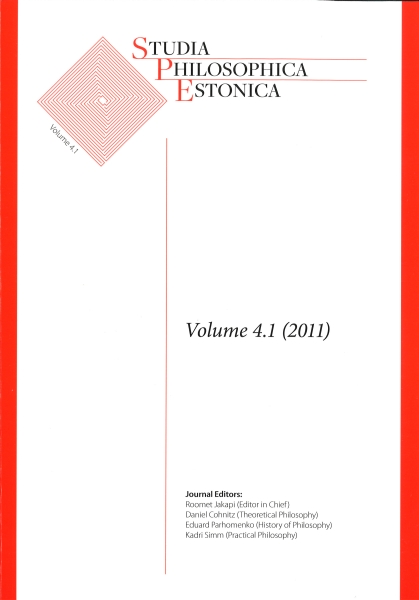Olenditeooria
DOI:
https://doi.org/10.12697/spe.2011.4.1.01Abstract
Käesoleva artikli eesmärgiks on välja töötada olenditeooria mõningad põhimõisted. Olendit määratletakse teatavate eristumisprotsesside lõimimisena ehk "läbivaatusena". Nendel protsessidel on kaks külge, "esi-" ja "isekülg". Esikülg on kõrvutuvuslik, st. paljusus, mille elemendid on üksteise kõrval; isekülg on läbistuvuslik, st. paljusus, mille elemendid läbistavad üksteist. Need kaks külge ei sarnane teineteisega ja nende vahel liikumine kätkeb taandamatut ajalisust, ontogeneesi. Artiklis laiendatakse olendi mõistet "vertikaalis" erinevatele keerukustasanditele (eluline, molekuliline, atomaarne jt) ja "horisontaalis" erinevatele individualiseeritusastmetele. Isekülge käsitletakse liigendatuna piki afekteerimis- ja afekteeritavusviise, mis tähistavad seda, mida olend suudab tajuda ja teostada, ehk seda, milleks ta on võimeline. Lõpuks käsitletakse esi- ja isekülge olemise kui protsessi kahe aspektina, esinemise ja isenemisena. Esinemise ja isenemise ringluste arvukus ja tempo variatiivsus määravad olendi väehulga.A Theory of Beings
The paper proposes to work out concepts for describing the individualization of beings on various levels of organization. A being with a certain degree of individuality comes into being when certain processes of differenciation are being integrated together. It is conceived of as having two aspects, self-relation (isekülg) and other-relation (esikülg). The former is a multiplicity where the elements interpenetrate each other and the latter is a multiplicity where the elements are exterior to each other (juxtaposition). The articulations of interpenetrating multiplicity determine how a being can affect its surroundings and be affected by it, and the modes of this articulation can be seen as attractors of the "phase-space" of a being. Ontogenesis is on the one hand the actualization of this virtual phase-space in an actual form with its characteristic ways of spatialization and temporalization. On the other hand, ontogenesis means the revirtualization of juxtaposing elements and processes. The number and intensity of these circuits determines the degree of power of a being. The paper proposes to extend all these notions also to pre-biotic systems.
References
Aristotele (2000). Metafisica: Testo greco a fronte, Bompiani, Milano.
Begon, M., Townsend, C. ja Harper, J. (2006). Ecology. From Individuals to Ecosystems, 3. tr, Blackwell Science, Cambridge.
Bergson, H. (2007). Sissejuhatus metafüüsikasse, Akadeemia 19: 1743-1778.
Boutang,P.-A.(2004). L’abecedaire de Gilles Deleuze, Editions Montparnasse, Paris. DVD.
DeLanda, M. (2002). Intensive Scienceand Virtual Philosophy, Continuum, London.
Deleuze, G. (1968a). Difference et repetition, Puf, Paris.
Deleuze, G. (1968b). Spinoza et le problème de l’expression, Minuit, Paris.
Deleuze, G. (2003). Spinoza. Philosophie pratique, Minuit, Paris.
Deleuze, G. (2008). Bergsonism, Ilmamaa, Tartu.
Deleuze, G. ja Guattari, F. (1980). Milles plateaux, Minuit, Paris.
Deleuze, G. ja Parnet, C. (1996). Dialogues, Flammarion, Paris.
Edelman, G. ja Tonioni, G. (2000). Consciousness. How Matter Becomes Imagination, Basic Books, New York.
Fraser, J. (1982). The Genesis and Evolution of Time, University of Massachusetts Press, Amherst.
Fromm, J. (2004). The Emergence of Complexity, Kassel University Press, Kassel.
Hermann, E.(2009). Valmisolek või valmis olek: skeptikute maailmatu maailm, Vikerkaar 10-11: 93-108.
Kant, I. (1790). Kritik der Urteilskraft.
Karik, H. (2000). Üldkeemia. Anorgaaniline keemia, Koolibri, Tallinn.
Kauffman, S. (1993). The Origins of Order. Self-organization and Selection in Evolution, Oxford University Press, Oxford.
Kauffman, S. (1995). At Home in the Universe: The Search for the Laws of Self-Organization and Complexity, Oxford University Press, New York.
Leibniz, G. W. (1714). Monadoloogia.
Maran, T. (2008). Mimikri semiootika, Tartu Ülikooli kirjastus, Tartu.
Ruyer, R. (1946). Éments de psycho-biologie, Puf, Paris.
Ruyer, R. (1952). Neo-finalisme, Puf, Paris.
Ruyer, R. (1958). La gense des formes vivantes, Flammarion, Paris.
Simondon, G. (1964). L’individuation a la lumire des notions de forme et d’information, Puf, Paris.
Spinoza, B. (1999). Ethique, Seuil, Paris.
Uexküll, J. v. (1981). The theory of meaning, Semiotica 42: 25-82.
Uexküll, J. v. (1992). A stroll through the worlds of animals and men: A picture book of invisible worlds, Semiotica 89: 319-391.





